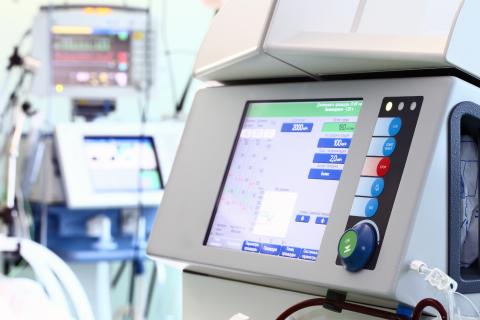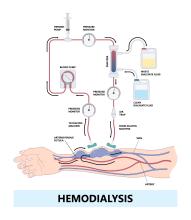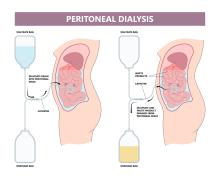Healthcare-Associated Infections: Infection Prevention in Dialysis Settings
The kidneys are essential organs that help clean blood and remove fluid and toxins from the body. When someone is in kidney failure, dialysis treatments may be needed to filter out fluid and toxins for the kidneys.
Dialysis treatments may happen in a variety of settings depending on the type of care needed.
Infection prevention and control practices should be in place to prevent health care-associated infections (HAIs) in these unique settings.
Infection prevention and dialysis
Below, you can find more information and resources on infection prevention in dialysis.
- Hemodialysis: This is the most common form of dialysis. A machine filters toxins and extra fluid out of the blood through a dialyzer (artificial kidney) and returns the blood back to the body through an access site.
- Peritoneal dialysis: This form of dialysis uses blood vessels in the peritoneum, which is the lining of the abdomen, to filter fluid and toxins from the blood and act as an artificial kidney.
- Arterial venous fistula (AVF): An AVF connects a patient’s own artery and vein to create a permanent dialysis access site.
- Arterial venous graft (AVG): An AVG is a synthetic implanted tube that connects a patient’s artery and vein to create a permanent dialysis access site.
- Central venous catheter (CVC): An CVC is a line used as a dialysis access site. It is placed into a blood vessel in the neck or upper chest with the tip ending in the right atrium of the heart.
Most patients who require dialysis treatments will need them three times each week. Treatments are typically provided by specially trained dialysis staff. Dialysis treatments settings may include:
- Outpatient dialysis facilities.
- Inpatient hospital settings.
- Skilled nursing facilities.
- The patient's home.
Hemodialysis
In order to receive hemodialysis, the patient must have a dialysis access site.
This type of access is either an AVF, AVG or CVC.
Access sites allow blood to be pumped out of the body to a machine where it is filtered and cleaned and then returned to the body.
Peritoneal dialysis
In order to receive peritoneal dialysis, a thin tube, called a peritoneal catheter, is surgically placed into the peritoneum.
The peritoneal catheter allows fluid to move in and out of peritoneal cavity to eliminate toxins and fluid.
This type of dialysis is typically done in the patient's home.
Infections are common among patients on dialysis. Bloodstream infections are the second leading cause of death in dialysis patients. According to the CDC (Centers for Disease Control and Prevention), patients on dialysis are 100 times more likely to get bloodstream infections than patients not on dialysis. Dialysis patients are also at higher risk for infections caused by bloodborne pathogens, such as hepatitis B, C, or HIV.
There are a number of infection risks associated with dialysis treatment. Infection risk factors include:
- Dialysis access type: CVCs are the highest risk dialysis access type. Reducing the use of this access type and utilizing lower risk access, types such as AVFs, can help prevent bloodstream infections.
- Environmental contamination: There are many surfaces and pieces of equipment that need to be properly cleaned and disinfected between patients, such as the dialysis machine, the treatment chair, and blood pressure cuff. Bloodborne pathogens can spread from person to person through blood or surfaces that have not been properly cleaned and disinfected. Cleaning and disinfection, as well as practicing hand hygiene, is one of the easiest ways to prevent infections among dialysis patients.
- Waterborne pathogens: Most hemodialysis facilities use a special water system for treatment. Improper water management can potentially expose dialysis patients to waterborne pathogens. Ensuring that water used to perform dialysis treatments is held to the Association for the Advancement of Medical Instrumentation (AAMI) standards can help reduce waterborne infection risk.
Steps health care personnel can take to prevent infections
- Practice proper hand hygiene before and after contact with the dialysis patient or their environment.
- Use proper personal protective equipment (PPE) when providing dialysis treatment, this includes gowns, gloves, and face protection.
- Use safe injection practices.
- Practice proper cleaning and disinfection methods, including using the correct Environmental Protection Agency (EPA)-registered disinfectant.
- Perform proper dialysis access site care.
The Wisconsin Department of Health Services is a member of the Making Dialysis Safer for Patients Coalition, a partnership of organizations and individuals that have joined forces with the common goal of promoting the use of CDC’s core interventions and resources to prevent dialysis bloodstream infections.
Steps patients can take to prevent infections
- Wash your hands often or use an alcohol-based hand sanitizer.
- Ensure your access site is kept clean and dry, including any bandages.
- Be aware of any signs or symptoms of infection, including redness, draining, swelling, or warmth. Talk to a doctor if you notice any of these symptoms.
- Ensure staff are following proper precautions when providing your dialysis treatment.
- Stay up to date on vaccines pneumonia, influenza, hepatitis B, and COVID-19.
For more information for patient safety, visit the CDC Be a Safe Patient webpage or Midwest Kidney Network website.
Resources
From the American Medical Society
The following trainings are offered by the American Medical Society in collaboration with CDC's Project Firstline. Continuing education credits are available.
- Hand Hygiene for Infection Prevention in a Dialysis Setting
- Injection Safety for Infection Prevention in a Dialysis Setting
- Personal Protective Equipment for Infection Prevention in a Dialysis Setting
From CDC
- Dialysis Safety
- Infection Prevention in Dialysis Settings: Continuing Education Course
- Making Dialysis Safer for Patients Coalition
- Project Firstline Infection Control Training Toolkits
From the Department of Health Services
- Signs and Symptoms of Infection: Dialysis Access, P-03591 (Also available in Spanish and Hmong): Health care providers and facilities offering dialysis are encouraged to print this fact sheet and share with their dialysis patients. Download and save the fact sheet to add your facility's contact information.
- Dialysis and Long-Term Care: Improving Practices and Communication webinar: This webinar provides information and considerations for dialysis care in long-term care facilities, including tips on improving practices and communication.
Need infection prevention assistance?
The Wisconsin HAI Prevention Program’s dialysis infection preventionist provides infection prevention consultation for dialysis settings. The services the program provides are educational, collaborative, non-regulatory, and free of charge. Services offered include:
- On-site and remote infection control assessments.
- Review of infection prevention processes to help identify needs or gaps.
- Infection prevention program and policy review.
- Education and technical support on infection prevention practices.
Contact us
Contact us by emailing Rebecca LeMay at Rebecca.LeMay@dhs.wisconsin.gov.




